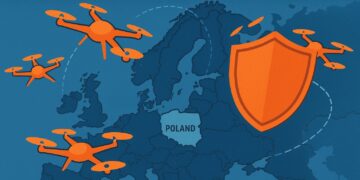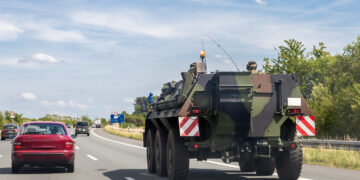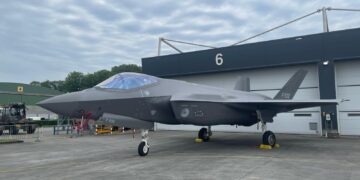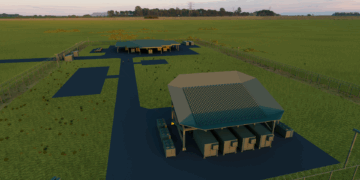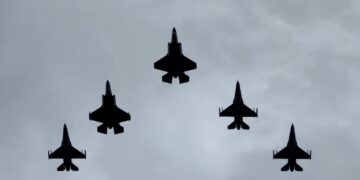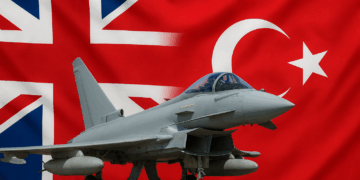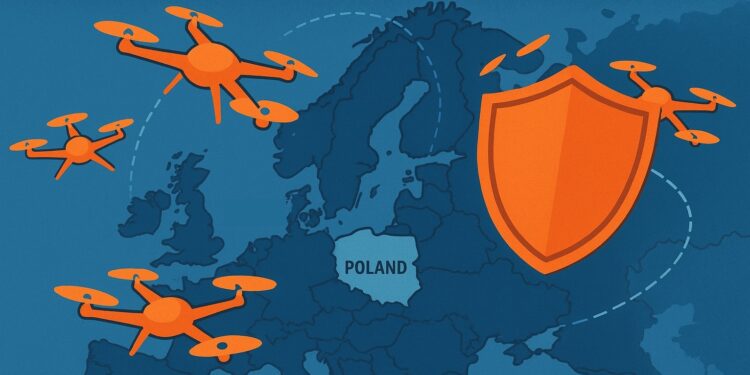By mid-September the warning signs were impossible to miss. Several Russian drones flew into Polish airspace. One stray might be dismissed as an accident, but in these numbers, Moscow had clearly crossed a line. Together with recent Baltic airspace violations by Russian fighter pilots, the incursions triggered sharp political condemnation. They also prompted immediate action: NATO rushed to launch Operation Eastern Sentry, sending fighter jets from several countries to secure its eastern flank.
Then, on Monday evening, a new problem appeared. Airports in Oslo and Copenhagen were shut down by unidentified drones, raising a more complex question: how can Europe defend itself when the threat moves beyond the battlefield and into civilian life?
Dutch 5th generation fighters
But first, back to the wave of drones in Poland earlier September. That evening, Polish air space was intruded by tens of drones during one of Russia’s largest strikes on Ukraine. When some strayed toward Polish territory, the air force was scrambled. Including newly arrived Dutch F-35s deployed to protect the critical NATO-hub funneling weapons to Ukraine.
“Russia is taking greater risks, and with that the threat to NATO territory is increasing. The Netherlands can play an important role in that defense within NATO, as was proven last night with the deployment of our F-35s. I am proud of the swift and professional response of our pilots,” Dutch Defense Minister Ruben Brekelmans said.
Soon after, NATO reinforced the eastern border with a mix of jets from Denmark, Germany, France, Italy, and the UK under Operation Eastern Sentry.
Expensive weapons, cheap drones
But heavy aircraft highlight a painful imbalance. Shooting down a drone with a missile costs many times more than the drone itself. That is why Polish Defense Minister Władysław Kosiniak-Kamysz has turned to Ukraine for lessons and ultimately a joint cooperation on anti-drone warfare: “Over more than three years of war, you have made an epochal leap in drone and anti-drone capabilities. We want to benefit from your knowledge and skills,” Kosiniak-Kamysz said.
That covers threats from outside. But what happens when drones suddenly appear from within Europe, with no clear sender?
Intro grey territory
The incidents at Copenhagen and Oslo airports showed the risks. Flights were canceled, terminals shut for hours, and the drones were never intercepted. Their origin remains a mystery, possibly launched from ships. The timing was striking: two major airports disrupted in the same way, at the same moment. The Danish prime minister has not ruled out Russian involvement.
From Dutch dome to European Wall
These incidents leave European policymakers scrambling. How do you stop small drones efficiently? Proposals are surfacing. In the Netherlands, the political party NSC has floated the idea of a national “Dutch Dome”, an anti-drone shield. The plan passed parliament and is now under review.
Brussels has also been jolted awake. On Friday, the European Commission will discuss the Drone Wall, first floated by Ursula von der Leyen in her State of the Union speech. Several eastern member states are already involved, and this week Denmark joined too.
“For those who still doubt the need to have a drone wall in the European Union: here we get another example of how important it is,” said Commission Defense spokesperson Thomas Regnier.
No easy answer
These initiatives don’t yet solve the costly “pinprick” attacks on European soil. But one thing has become clear: Europe needs stronger defenses. That means blocking hostile drones from outside — and protecting critical infrastructure within its borders.
